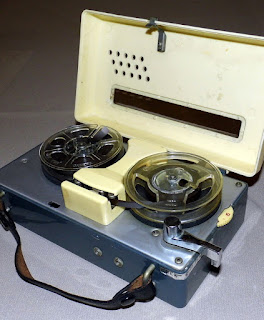From Reel to Real: Louis Armstrong and Personal Recording
By Simon Hodgson
For Louis Armstrong, a man who experienced the world through sound, recording himself came naturally. When commercially manufactured reel-to-reel tape recorders became available in the late 1940s, Armstrong was an early adopter. He was introduced to the new machines by his friend Bing Crosby, who saw the value in the magnetic tape technology exported from post–World War II Germany. The trumpeter invested in a Recordio reel-to-reel tape machine manufactured by Wilcox-Gay Corporation and took the bulky device with him on the road, transporting it in a steamer trunk.
While Crosby went on to use reel-to-reel tapes professionally and revolutionized broadcasting (he prerecorded radio shows rather than performing live), Armstrong used the new equipment in a more personal way. Initially, Armstrong used the audio technology to record his stage performances, enabling him to listen to and polish his sets. Gradually, however, he started recording ordinary life as well. He would tape postshow radio interviews, intimate conversations with dressing room visitors, dirty jokes with friends, or just himself tinkering around at home while watching a baseball game on television.
For Louis Armstrong, a man who experienced the world through sound, recording himself came naturally. When commercially manufactured reel-to-reel tape recorders became available in the late 1940s, Armstrong was an early adopter. He was introduced to the new machines by his friend Bing Crosby, who saw the value in the magnetic tape technology exported from post–World War II Germany. The trumpeter invested in a Recordio reel-to-reel tape machine manufactured by Wilcox-Gay Corporation and took the bulky device with him on the road, transporting it in a steamer trunk.
While Crosby went on to use reel-to-reel tapes professionally and revolutionized broadcasting (he prerecorded radio shows rather than performing live), Armstrong used the new equipment in a more personal way. Initially, Armstrong used the audio technology to record his stage performances, enabling him to listen to and polish his sets. Gradually, however, he started recording ordinary life as well. He would tape postshow radio interviews, intimate conversations with dressing room visitors, dirty jokes with friends, or just himself tinkering around at home while watching a baseball game on television.
 |
| A reel-to-reel tape recorder. Photo by Joe Haupt. |
By the time he died in 1971, Armstrong had 650 reels of taped personal conversations as well as thousands of music recordings stashed in his house in Queens. For researchers, the hundreds of reels stored in an archival center in the Queens College library in Flushing, New York, are a gold mine. Previously, biographers had to track down Armstrong’s old collaborators for nuggets of information. Now, they can listen directly to the source. Author, drama critic, and playwright Terry Teachout used these tapes in writing his biography of Armstrong, Pops, as well as the play Satchmo at the Waldorf. Actor John Douglas Thompson, who plays Armstrong in Satchmo, also traveled to Flushing to listen to the tapes and hear the difference between the cultural icon and the man: one folksy, upbeat, and entertaining, the other capable of rage, resentment, and joy.
History has a way of revealing the flaws of the famous. Generals, presidents, and sports stars usually fade in the unblinking glare of hindsight. But in the recordings he left, Armstrong emerges stronger, more human, more believable. Yes, he could be angry, or crude, or embittered. But even in his most vulnerable moments—exhausted or irritated, high on his beloved “gage” (marijuana) or trying to get his wife into bed—he was never afraid to reveal himself.
Armstrong had a sense of himself as a public figure and a cultural leader. That explains his 1954 autobiography, about a musician who comes from the streets of Storyville and rides his talent to the top. He was proud of his rags-to-riches story—it was true, and he wanted people to hear it—but there was more to his life and personality than that one narrative, and he wasn’t afraid of sharing it with the public. It is that sense of himself as a historic figure that explains his frequent references in the tapes as to why he was making the recordings: “It’s for posterity.”
Armstrong didn’t just leave behind recordings. The Queens College library archive contains a trove of information for fans of the jazz man, including more than 80 scrapbooks full of newspaper articles and photos, 1,600 phonograph records, and even books by his nutrition advisor, Gayelord Hauser, the German-born doctor who became a Hollywood guru preaching the virtues of natural foods and laxatives.
Armstrong’s hundreds of recorded personal conversations show more than just a man who lived life through music. They disclose a musician of stature and integrity, who retained a sense of himself as a public figure—a jazz trumpeter who came from the streets and rode his talent to the very top. In the end, they reveal a man who was able to look history in the eye and be at peace with himself, his feats, and his foibles.
*To learn more about the man behind the trumpet, click here to purchase a hard or digital copy of Words on Plays, A.C.T.'s in-depth performance guide series. All proceeds go to our ACTsmart education programs, serving teachers and students throughout the Bay Area.

